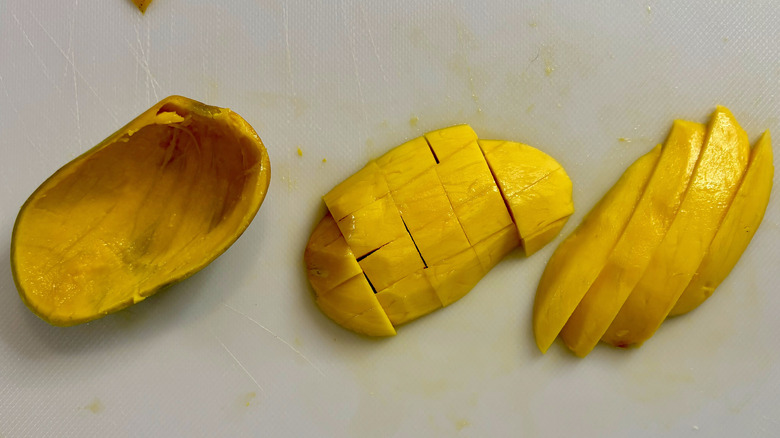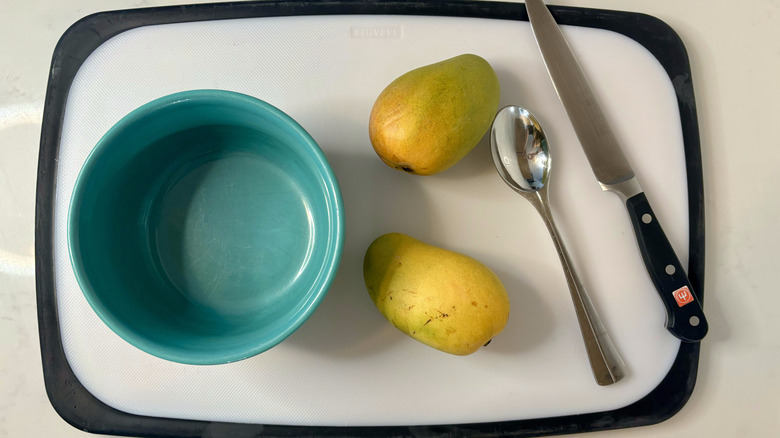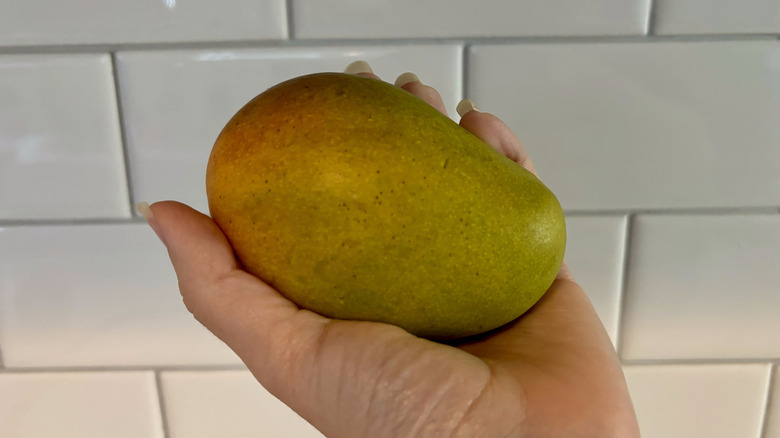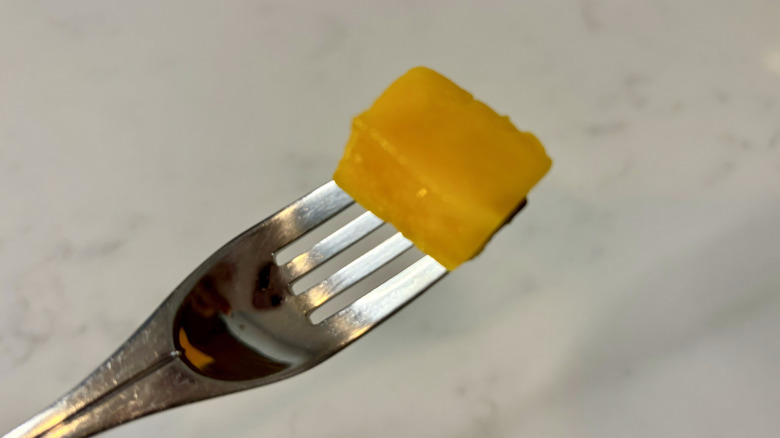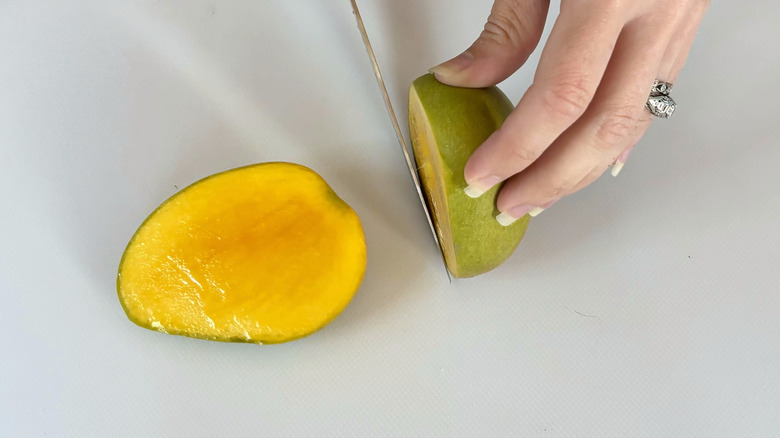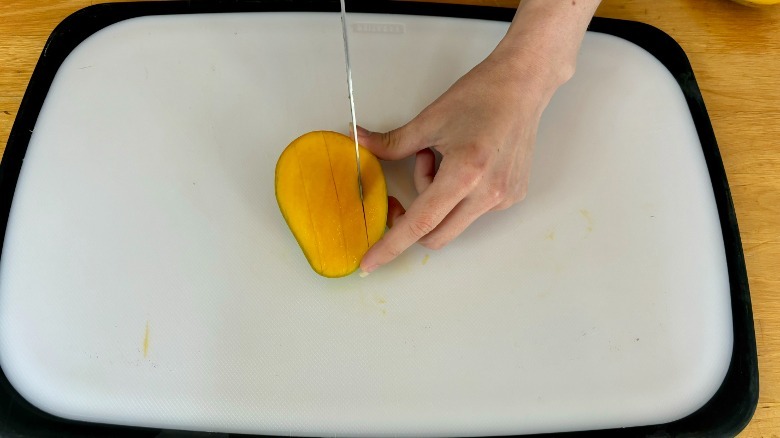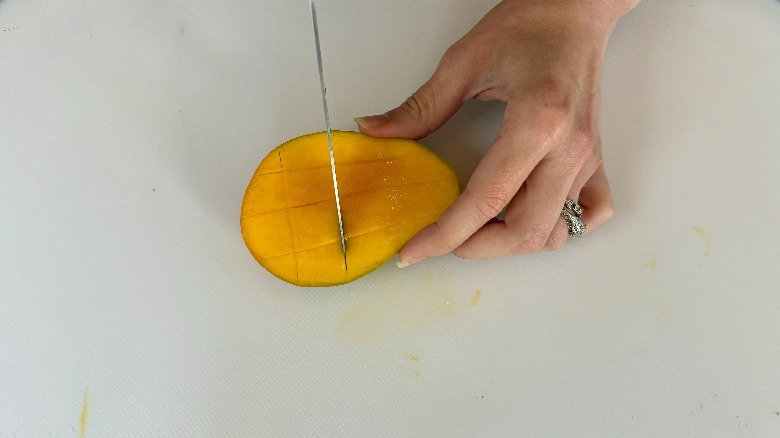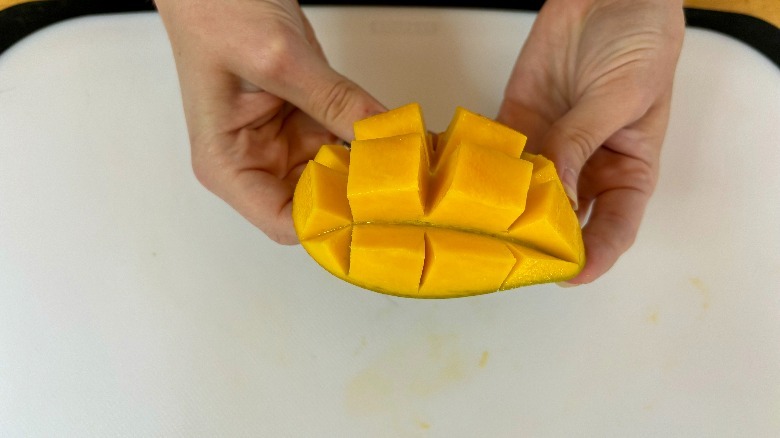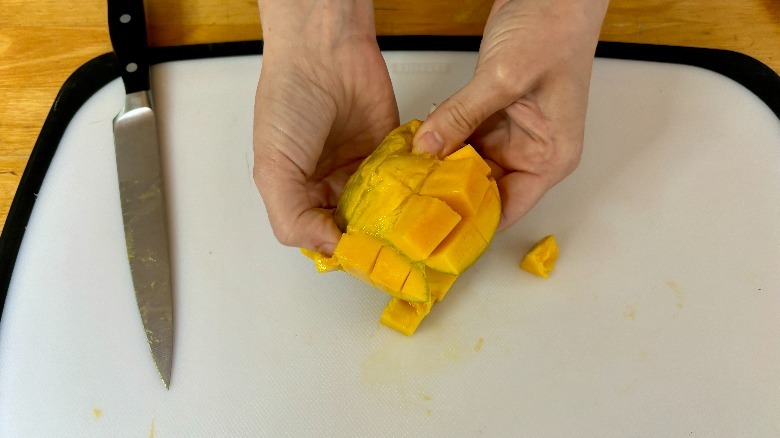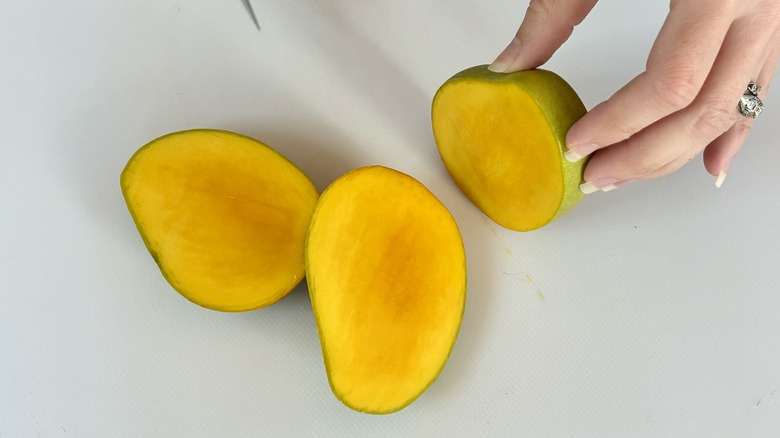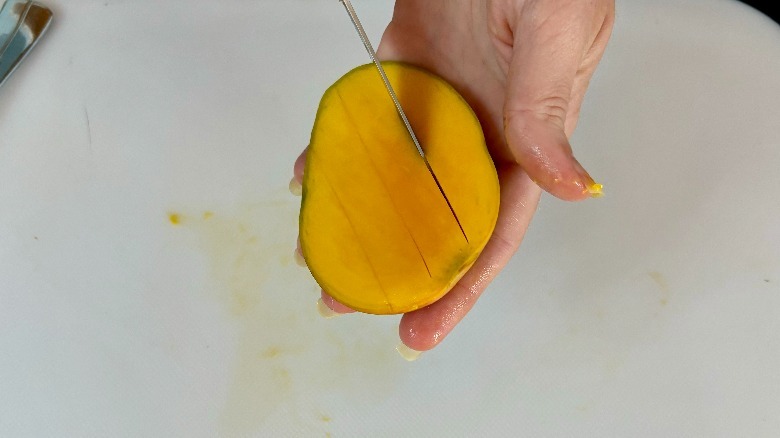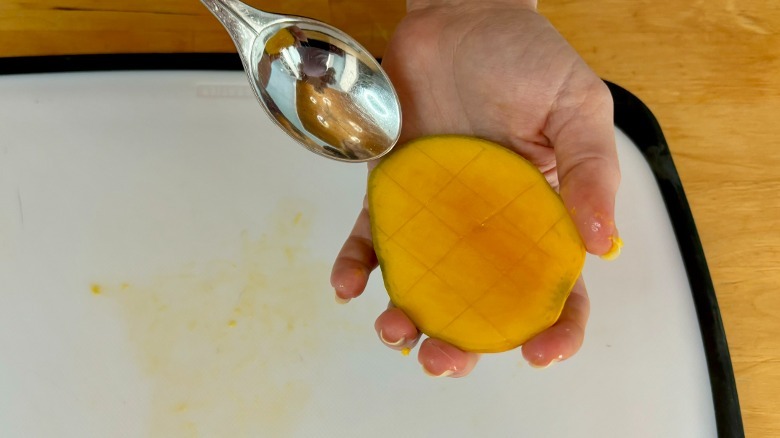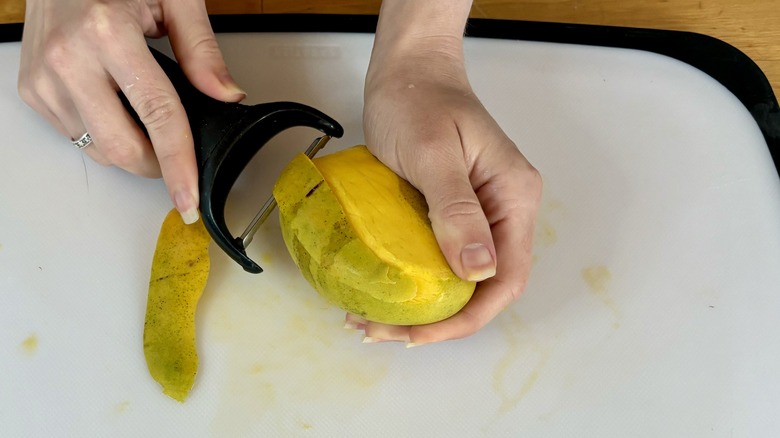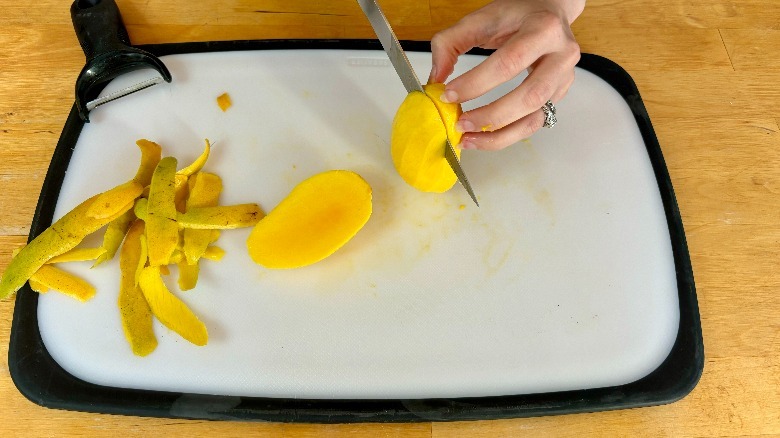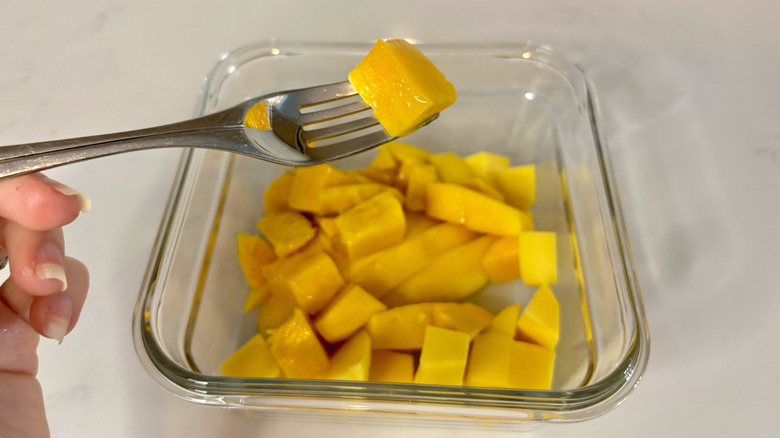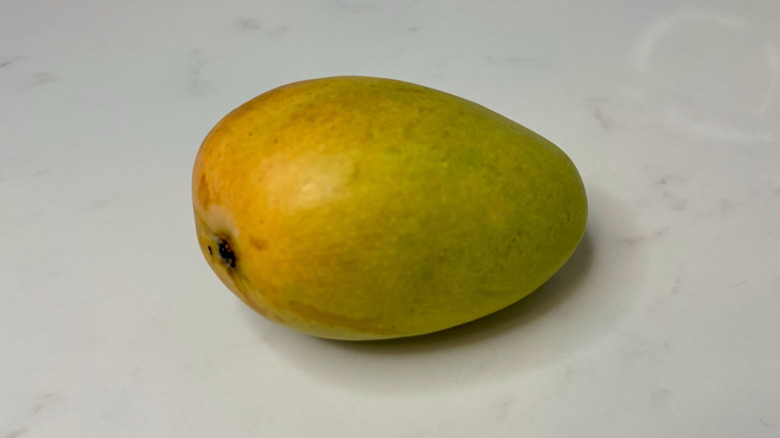How To Cut A Mango, 3 Easy Ways
Cutting mangoes can be an intimidating process. The fruits are sweet, delicious, and bursting with flavor, but many will forgo this tropical delight because they don't realize just how easy it is to cut them.
Mangoes pose two main challenges: a tough inner pit and a thick leathery skin. While this means you must take a different approach to cutting mangoes than, say, an apple, it does not preclude even a novice chef from slicing and dicing them up. What's more is you don't even need a special mango cutter. These unitaskers just take up space in your kitchen and provide a mediocre cut.
While you can buy pre-cut mangoes in the store, they are far more expensive than buying the whole fruit. You don't get to choose the cut, and there is no guarantee they are using fresh and ripe mangoes. We will show you three different easy ways to cut and prepare a mango so that when mango season rolls around, you can enjoy the fruit when it is ripe.
Tools you will need
As we mentioned, you do not need to buy any special equipment. You will need a mango, a cutting board, and a bowl to put your cut mango in. You may also want a kitchen rag, as mangoes are incredibly juicy.
Other than those, you will need a sharp chef's knife. Make sure your knife is sharp, as in most cases it needs to be able to go through the skin of the mango. Contrary to what some might think, a sharp knife is actually safer than a dull one. Finally, if you are using the peeling method, you will need a fruit peeler. Because mango skin is thick, we recommend a Y-peeler.
Picking a ripe mango
For optimal enjoyment, it's critical that you pick a ripe mango. Mango season is between May and September; this is typically when you will find the best. Mangoes come in a variety of shades, so looking at the color is not a good way to pick your fruit. Instead, we recommend feeling your mango. Like many fruits, mangoes are ripe when they are just a little squishy. If you pick up a mango that is as hard as a rock, that mango is under-ripe and should be cut later.
If you do buy unripe mangos, leave them at room temperature for a few days. Check back regularly until you feel the mango become ripe. Mangoes will ripen on the counter; all you need to do is wait.
Common mango-cutting mistakes
One of the most common mistakes with mangoes is trying to cut through the pit. Mango pits may not be as visually obvious as those of other fruits, but they are there and will prevent you from cutting your mango if you are not careful. Be sure to cut off to the side and not down the middle of the fruit; this leaves space for the pit.
With that in mind, when you cut the mango, most of your fruit is going to come from what are known as the "cheeks." When you look at a mango, they are not perfectly round. Instead, they are oblong, with sides that are too wide and too narrow, which poke out. Some people think cutting the narrow protruding side is the best place to start, but that will just yield you a small, pitty chunk of mango. Instead of using all-mango cutting methods, we cut the wide "cheeks" off before cutting further. This gives you two luscious chunks of mango to work with.
Scoring your mango
Start by cutting off the cheeks of your mango. For better stability, you can cut a small section off of the end of your mango. Then, stand your mango on its end and cut off the cheeks. The cuts will not be made down the middle but slightly off-center. This will give you an easy grip for the center and give you two wedges of mango.
Take one mango wedge with the fruit side up and use your sharp knife to cut vertical lines down the center. Instead of cutting all the way through, apply enough pressure to get through the flesh, but not the tough skin.
Next cut horizontal lines at your desired intervals to create a grid of mango squares. Repeat with the second side.
Invert the mango peel so that the chunks are on the outside.
Remove the chunks from the skin. Some will easily peel off by using your thumb to apply pressure on the bottom. If you would prefer, you can use the knife to cut off each of the cubes. In the end you will have perfectly cubed mangoes.
Using a spoon
Stand your mango on its end and cut off the cheeks. The cuts will not be made down the middle but slightly off-center. This will give you an easy grip for the center and give you two wedges of mango.
From here, you have two options: you can either use your knife to score your mango, such as above, or you can leave it whole. If you want to score your mango, take the wedge of mango and apply enough pressure to your knife to cut through the fruit, but not the skin. You can cut slices or squares.
After you have made your desired shapes or have decided to leave your mango whole, take your spoon and scoop out the pieces of fruit.
If your mango slice is whole, you can either take scoops out and eat the fruit this way, or you can use your spoon to scoop out the whole chunk of fruit, working your way around the half to remove the flesh from the peel, much as you would with an avocado.
Peeling method
Hold your mango in your non-dominant hand. Take your Y-shaped peeler and begin to remove the peel in long strips. Rotate all around the mango until all the peel is removed. Then, place mango on the cutting board.
With your sharp knife, remove the cheeks of your mango. If you have a fleshy mango, you can also cut off the two small edges that are left.
Place your mango cheeks flat side down and slice into whatever shape you want. This can be slices or cubes of any size or shape.
How to store a mango
Mangoes can be stored in a number of ways. Unripe mangoes should be stored on the counter until they reach peak ripeness. At that point, they can either be cut or put in the fridge for up to five days to delay further ripening.
Once mangoes have been cut, they can also be stored in the refrigerator. They should be placed in an airtight container and kept in the refrigerator for a couple of days.
Mangoes can also be placed in the freezer by being put in an airtight container or bag and removing as much extra air as possible. They can stay frozen for about six months.
Recipes that use mango
Mangoes are delicious and can be enjoyed on their own but they can also be used for a whole host of delicious recipes. Mango Sago is a cool and refreshing tapioca pudding dessert.
If you want a mango sweet treat and are willing to do a sort of science experiment, try these peelable mango gummies. But mangoes aren't just for desserts — can add some diced mango to your next poke bowl for a beautiful blend of sweet and savory.
